
Chapter 5: Craters (2/6)
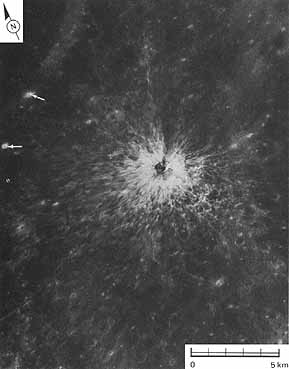 |
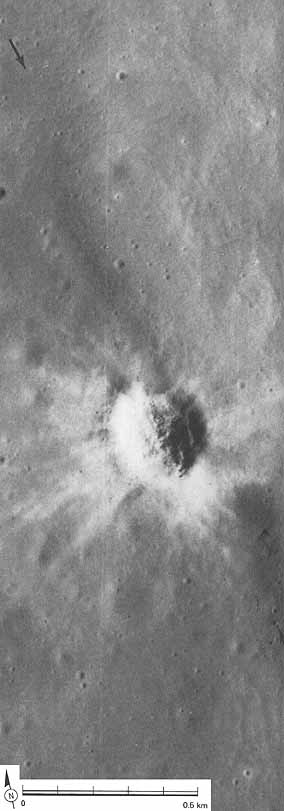 |
|
[116] FIGURE 108 [above].-Another fine example of a small crater with extensive bright rays. It presumably was formed by meteoroid impact. Both light and dark rocks are visible in the walls, indicating that more than one layer of rock was penetrated. Rays formed by secondary craters, blocks, and pulverized ejecta extend more than 13 crater diameters beyond the crater proper. The marked irregularity of the pattern southeast of the crater probably was caused by topographic irregularities that deflected the radially outward movement of the ejecta. Arrows indicate smaller bright- rayed craters.-M.W.
| |
|
FIGURE 109 [right].-The configuration of this small crater has been affected by the topography of the impact site. It is located near the eastern edge of Mare Serenitatis, north of the Apollo 17 landing area. The body that excavated the crater impacted at the foot of a westward-facing fault scarp that bounds one side of a graben, or fault trough. The fault scarp is coincident with the diffuse narrow band of shadow extending between the arrows; the area west of the scarp, the floor of the graben, is noticeably lower than the area to the east. The flow of ejected debris toward the east was apparently blocked by the scarp, resulting in an abbreviated bright halo and ray pattern in that direction.-G.G.S. |
[117] FIGURE 110 [below].- An oblique view looking northwest at part of the wall of the crater Lobachevsky on the lunar far side. It shows a small crater on Lobachevsky's wall with unusual streaks of dark material that appear to have originated from the lower rim of the structure and to have moved down toward the floor of Lobachevsky. This feature was first noticed by T. K. Mattingly, the Apollo 16 CMP, who described the darker streaks as probable lava flows (Mattingly, El-Baz, and Laidley, 1972). However, the streaks can also be explained by the downslope movement of dark fragmental debris excavated from Lobachevsky's wall by the small crater. Closer to the lower border of the photograph is a bright area extending across Lobachevsky's rim. This area and other sinuous light-colored markings in the upper half of the photograph are on the periphery of an enormous field of light-colored swirls in this part of the far side (El-Baz, 1972a). The origin of the swirls is not well understood.-F.E.-B.

|
[118] |
 |
FIGURE 111 [above].-For easier viewing, this picture is oriented with north at the bottom of the page. It shows the striking bilateral symmetry of the rays of a small (2-km diameter) crater in the floor of the large crater Daguerre in Mare Nectaris. Continuous areas and narrow filaments of light-gray ejecta extend from the crater across the dark mare surface through 270°, but are entirely absent in the southern 90° sector. Within the crater, dark material occurs on the southern crater wall while the remaining walls are bright. (The reader may wonder about the material whose reflectivity cannot be observed because it lies in shadow on the east wall of this crater. Until the area is observed under high Sun conditions, we are forced to make the simplifying assumption that it is bright because most of the materials visible elsewhere in the walls are bright.) This crater probably resulted from the impact of a projectile traveling from south to north along an oblique trajectory. Its pattern of ejecta distribution is similar to that of small craters produced by the impact of missiles along oblique trajectories at the White Sands Missile Range, N. Mex. Some observers postulate that the dark material is a talus deposit of mare material that has fallen into the crater.-H.J.M.
Another geological explanation is that the unusual pattern may be due to an intrinsic characteristic of the local terrain, probably an abrupt lateral change in the composition of the bedrock within the area that was excavated. F.E.-B.
|
[119] FIGURE 112 [right].-This small young crater has an incomplete ray pattern. It is located in central Mare Serenitatis. The small raised features on the flanks of the crater are blocks of ejected bedrock, probably mare basalt. The largest is about 30 m across. In this picture, where sunlight is from the east (right), raised features appear as bright spots casting a shadow to the west. Note the relative scarcity of blocks on the side lacking rays. The absence of rayed ejecta and of discrete blocks to the west suggest that the impacting body was traveling from west to east along an oblique trajectory. The roughly concentric ledges in the rayed crater result from the interaction of shock and stress waves with the layered substrata.-H.J.M.
|
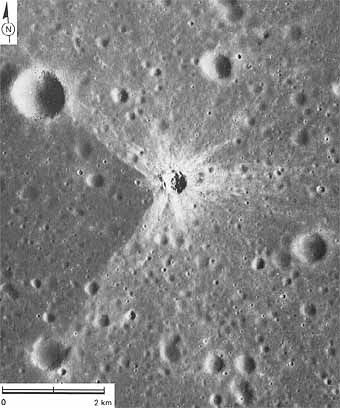 |
|
| |
|
FIGURE 113 [right].-This elliptical crater is 1 km long with an unusual, winglike pattern of rays. This ejecta pattern is similar to those around some small experimental impact craters produced by missiles traveling along low-angle trajectories at White Sands Missile Range, N. Mex. From the shape of the crater and the distribution of the rays, it is difficult to tell whether the meteoroid was traveling from north to south or south to north. The higher albedo (brightness) of the north wall and the concentration of high albedo ejecta on the northwest and northeast flanks suggest that it traveled from south to north.-H.J.M.
|
 |
|
[120] |
 |
FIGURE 114 [above].-This is an oblique view of another crater that probably was formed by a meteoroid following a relatively low-angle trajectory. This crater, 4 km in diameter, is located in the highlands east of Mare Serenitatis. Compared to the crater just described (see fig. 1 13), this one is less elliptical and its bilobate ray pattern is much less pronounced. The differences may be attributed to a higher trajectory angle of the impacting body that formed this crater as it struck the surface. H. J. Moore (1976), in his study of craters formed by impacting missiles at White Sands Missile Range, recognized a characteristic asymmetric profile along the axis of trajectory for craters formed in this manner. The wall beneath the missile trajectory is typically less steep than the opposite or down-trajectory wall, and its rim crest is lower and more rounded. These observations, when applied to the lunar crater in this photograph, indicate that the impacting body was traveling toward the east when it struck the Moon.-H.M.
|
[121] |
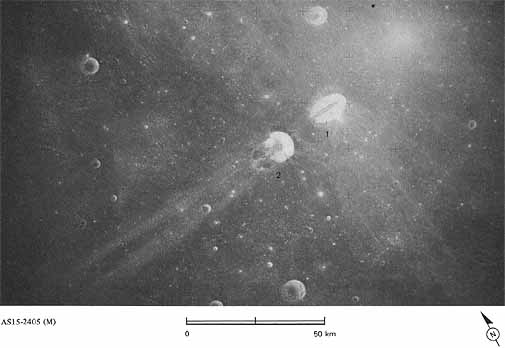 |
|
FIGURE 115 [above & below].-Messier (1) and Messier A (2) are a pair of unusual craters in northwestern Mare Fecunditatis. Messier is elliptical and has bright walls and light rays of ejecta extending at right angles to its long axis (approximately 16.5 km). Messier A is a doublet crater having two very long rays or filaments of ejecta extending westward from it. The east part of the doublet has steep, bright walls, whereas the west part is dark and appears mantled. Differences between the two parts are more clearly shown in this oblique view of Messier A composed as a stereogram. Both Messier and Messier A resemble some small experimental impact craters produced in sand by projectiles following shallow trajectories (4° or less from the horizontal) at velocities of approximately 1.7 km/s. In separate experiments using single projectiles, both elliptical craters with lateral ejecta lobes and doublet craters have been produced. Thus, it can be inferred that these lunar craters were produced by high velocity projectiles following shallow trajectories. By further analogy with the experiments, the projectiles that formed Messier and Messier A apparently traveled from east to west.-H.J.M.
| |
 |
|
[122] |
 |
FIGURE 116 [above].-Impact craters with asymmetric ray patterns and profiles can be caused by conditions other than the angle of trajectory. This 5-km crater was formed when a meteoroid impacted on the northeast rim crest of Gibbs, a very much larger and older crater near the Moon's east limb. In this restricted view, Gibbs' rim is the dark area in the north half of the picture, and its wall is the light area in the south half. The rim crest extends from arrow to arrow. Discrete rays of both light and dark ejecta are well developed around the north half of the small crater where they were deposited on a relatively level surface. They are poorly developed around the south side of the small crater, probably having been partly destroyed by mixing as the ejected materials cascaded down the much steeper wall of the crater Gibbs. Subsequent erosion has further destroyed the original pattern. The configuration of the small crater's rim has also been affected by topography. It is sharply defined along the north side but is barely discernible along the south side where large volumes of material have slumped down the wall of the older crater.-G.W.C.
|
[123] |
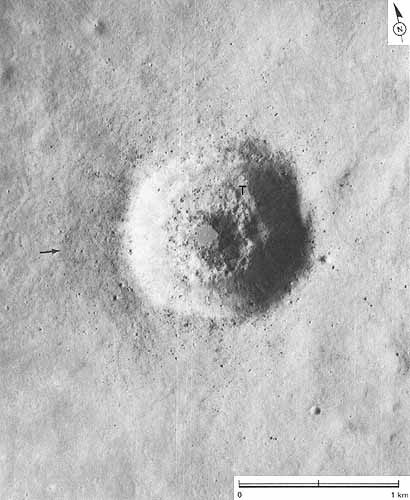 |
FIGURE 117 [above].-Remarkable detail is shown in this enlargement of a small part of a panoramic camera frame. In most respects, the crater itself is typical of a great many craters its size-about 1.2 km. Because it does not have rays, it is believed to be older than most other craters discussed previously in this chapter. Its rounded rim crest and slightly raised rim (extending outward to the arrow on the west side) also point to its greater age. On the other hand, it is young enough that some of the original dunelike texture of the ejecta blanket is preserved (especially to the west), a great many large blocks of ejecta are still visible, and the original depth of the crater has not been greatly lessened by infalling debris. The largest blocks, which are about 30 m in size, occur near the rim. The terrace (T) extending partly around the wall about 100 m below the surface probably marks the top of a resistant rock layer. However, if there were other signs of bedrock stratification within this crater, they have been obscured by the movement of debris down the walls. The very smooth floor is the only unusual feature of this crater. It may consist of a solidified pool of rock melted by heat generated from the impact.-H.J.M.
|
[124] |
 |
FIGURE 118 [above].-Kant P is the larger of these two craters in the central highlands on the Moon's near side. About 5.5 km in diameter, its overall shape is not in the least unusual. However, the younger, small pear-shaped crater on Kant P's north wall is an excellent example of the controlling effect that topographic relief plays on the shape of an impact crater. Because the small crater was formed on a steeply sloping surface, its ejecta was deposited chiefly downslope and formed a broad rim. The original rim and wall on the upslope side have been obliterated by slumping. The slumping has left a landslide scar and has caused talus and scree to be deposited in the lower part of the crater.-H.J.M.
[125] FIGURE 119 [below].-This oblique view of the crater Isidorus D was taken with the panoramic camera on Apollo 16. Isidorus D is about 15 km in diameter and is located in the highlands between Mare Tranquillitatis and Mare Nectaris. Evidence of avalanching (Howard, 1973) and of other types of downslope movement of material are clearly visible on the inner walls of the crater. The streaks resembling shooting stars on the left wall appear to be avalanche scars. The avalanches probably were spearheaded by large blocks followed by fine-grained material. On the near wall (arrow) a larger landslide terminates in a straight line against the relatively flat crater floor. In the shadowed part of the crater wall many short irregular benches or narrow terraces mark the tops of masses of slumped material. The brightness of the avalanche scars is an indication of their freshness; in general, freshly exposed lunar materials are brighter than undisturbed materials nearby.- F.E.-B.
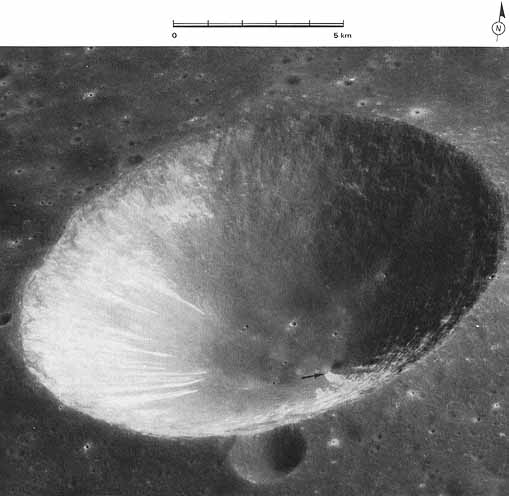
|
[126] FIGURE 120 [right].-Not quite all the craters on the Moon are natural features. About 28, and possibly as many as 36, according to Ewen A. Whitaker of the Lunar and Planetary Laboratory, University of Arizona, have been caused by man. Only about five of these artificial craters have been visually identified. One of them (centered in the small rectangle) is shown in this enlarged portion of a panoramic camera frame of 24 km2 in western Mare Cognitum. The more than 2400 craters visible in this small area are typical of the density of craters in many areas of the Moon. First located by Whitaker (1972), the manmade crater is easily identified by its pattern of dark rays interspersed with a few light rays. It was created in February 1971 by the SIVB stage of the Apollo 14 launch vehicle, which was directed to crash onto the lunar surface to generate seismic waves for detection by seismometers set up at the Apollo landing sites. The surface trace of the SIVB's trajectory is shown by a dashed line.-H.J.M.
|
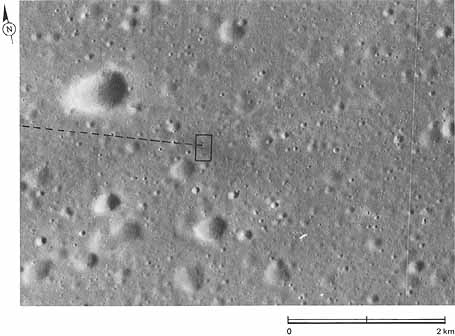 |
|
| |
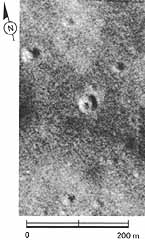 |
FIGURE 121 [left].-The same crater of figure 120 is shown in more detail in this photograph, an enlargement of the area indicated by the rectangle in figure 120. About 40 m in diameter, the crater differs from most natural impact craters in this size range by having a prominent central peak.-H.J.M.
|
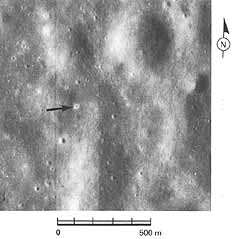 |
[127] FIGURE 122 [left].-An enlargement (approximately 15X) of a panoramic camera photograph showing a crater (arrow) formed in Mare Cognitum by the impact of the Ranger 7 spacecraft. Following an oblique trajectory, Ranger 7 struck the lunar surface on July 31, 1964, while traveling at a velocity of 2.65 km/s. The resulting crater is about 14 m across. Its bright ejecta blanket contrasts with the generally dark blanket around the SIVB crater and is more typical of natural lunar impact craters.-H.J.M. |
|
| |
 |
FIGURE 123 [left].-An enlargement of approximately 40X showing another manmade crater. This crater was excavated in the floor of the large near-side crater Alphonsus on March 24, 1965, by the Ranger 9 spacecraft. Prior to its crash, Ranger 9 had transmitted the highest resolution imagery obtained to that date from any spacecraft. Both Ranger vehicles impacted on mare surfaces while traveling at the same velocity along trajectories with the same inclination. It is, therefore, not surprising that the Ranger 7 and 9 craters have, within half a meter, the same diameter.-H.J.M.
|
| Next |